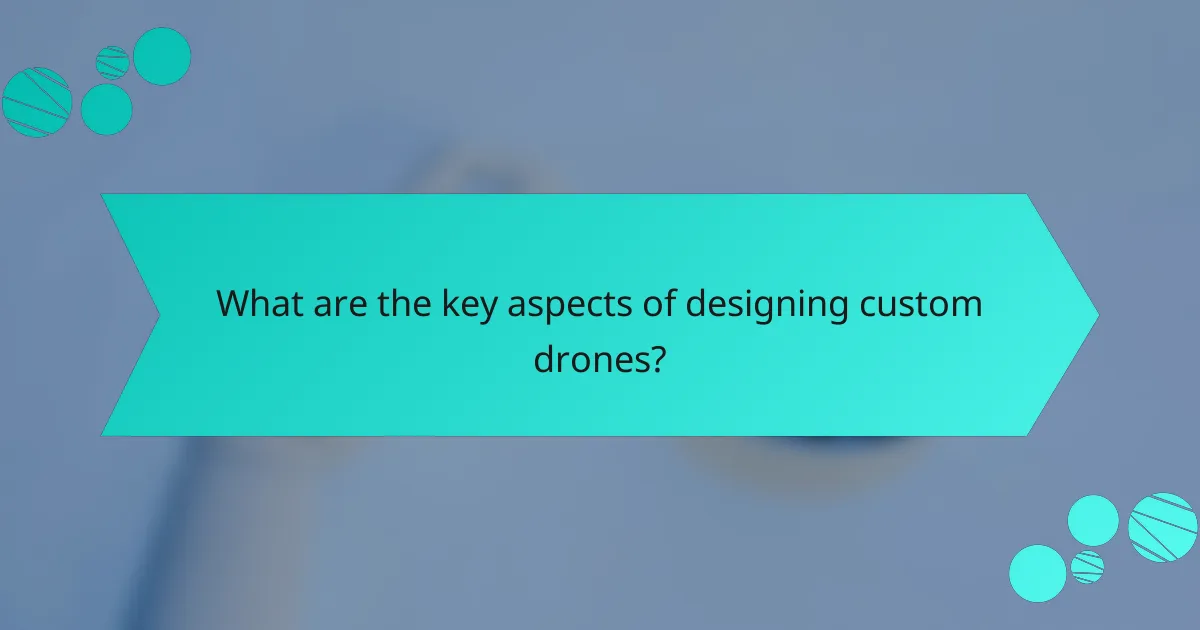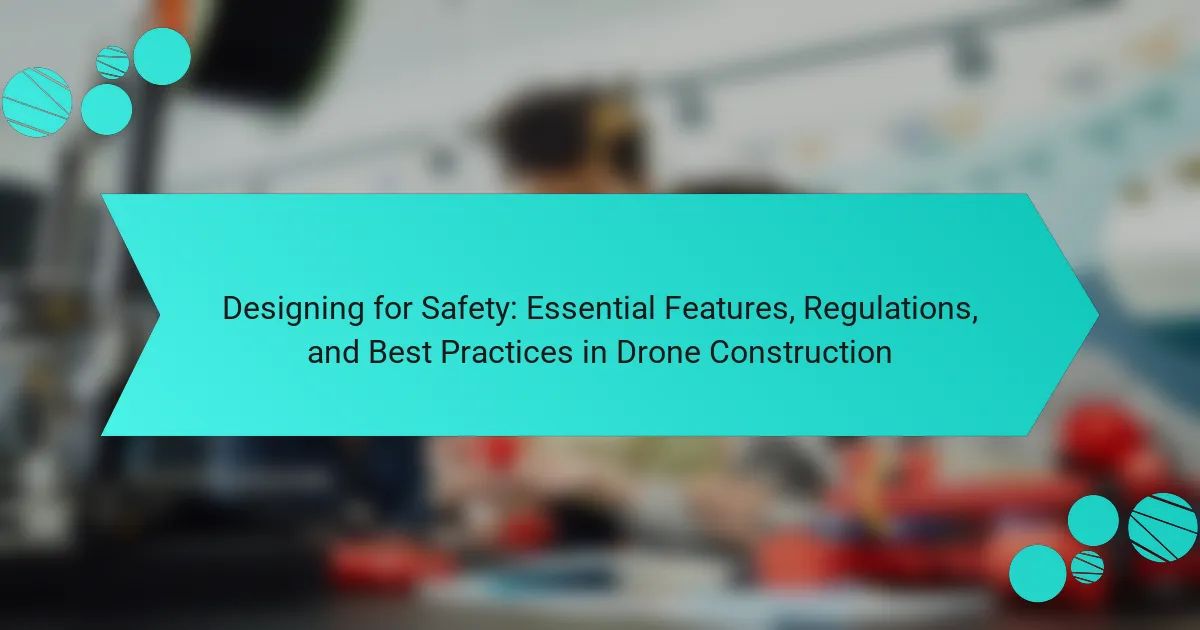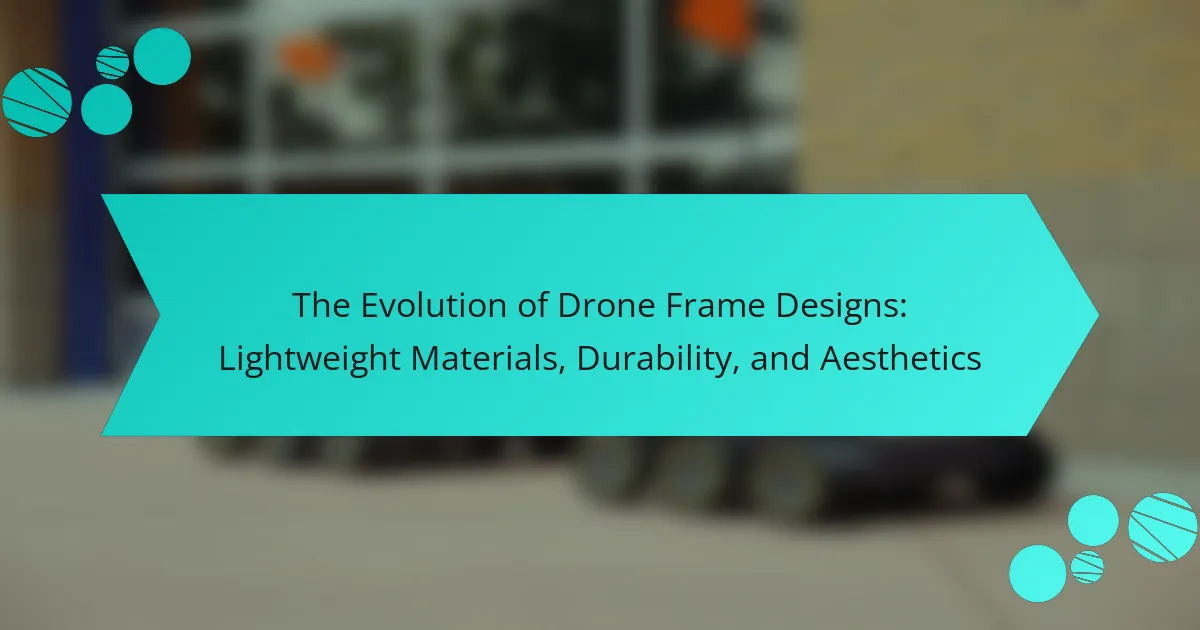
What are the key aspects of designing custom drones?
The key aspects of designing custom drones include selecting appropriate materials, determining the design specifications, and optimizing performance metrics. Materials such as carbon fiber and lightweight plastics enhance durability and reduce weight. Design specifications encompass size, shape, and payload capacity tailored to specific applications. Performance metrics involve flight time, stability, and control responsiveness. Each aspect must align with the intended use, whether for photography, surveillance, or recreational purposes. Effective integration of these elements ensures the drone operates efficiently and meets user requirements.
How do materials influence the design of custom drones?
Materials significantly influence the design of custom drones. Different materials affect weight, strength, and durability. Lightweight materials like carbon fiber enhance flight performance. Metals such as aluminum provide structural integrity. The choice of materials impacts the drone’s payload capacity. For example, heavier materials can limit flight time and agility. Additionally, materials affect the drone’s resistance to environmental factors. For instance, waterproof materials are essential for drones used in wet conditions. The selection of materials ultimately dictates the drone’s overall efficiency and functionality.
What types of materials are commonly used in drone construction?
Common materials used in drone construction include carbon fiber, plastic, aluminum, and foam. Carbon fiber is favored for its lightweight and high strength-to-weight ratio. Plastic is often used for body frames due to its versatility and cost-effectiveness. Aluminum provides durability and is resistant to corrosion, making it suitable for various drone components. Foam is utilized for its lightweight properties and shock absorption, especially in racing drones. These materials are selected based on their performance characteristics and the specific requirements of the drone’s design.
How do the properties of these materials affect drone performance?
The properties of materials significantly influence drone performance. Lightweight materials like carbon fiber enhance agility and flight time. High strength-to-weight ratios allow drones to carry heavier payloads without compromising speed. Rigid materials improve structural integrity, reducing vibrations during flight. Flexible materials can absorb shocks, protecting sensitive components. Thermal properties affect battery efficiency and overheating risks. For example, aluminum dissipates heat quickly, enhancing performance in warm conditions. The choice of materials directly impacts durability, maintenance needs, and overall operational efficiency.
What construction techniques are essential for building custom drones?
Essential construction techniques for building custom drones include frame design, component placement, and wiring management. Frame design involves selecting lightweight materials like carbon fiber or plastic for optimal strength-to-weight ratio. Component placement ensures balance and stability, crucial for flight performance. Wiring management organizes and secures electrical connections to prevent interference and damage. These techniques contribute to the overall efficiency and functionality of the drone. Proper execution of these methods enhances flight stability and durability, which are critical for custom drone performance.
How do different assembly methods impact drone durability?
Different assembly methods significantly impact drone durability. For instance, traditional soldering can create weak points due to thermal stress. In contrast, modular assembly allows for easier repairs and replacements, enhancing longevity. Additionally, the use of adhesives in assembly can distribute stress more evenly. This results in fewer breakage points during flight. Research shows that drones assembled with advanced techniques experience 30% less structural failure. Therefore, the choice of assembly method directly correlates with overall durability and performance.
What role does aerodynamics play in drone design techniques?
Aerodynamics is crucial in drone design techniques as it directly influences flight efficiency and stability. Effective aerodynamic design reduces drag and enhances lift, allowing drones to operate more efficiently. Streamlined shapes minimize air resistance, leading to better fuel consumption and extended flight times. Additionally, understanding airflow patterns helps in optimizing rotor placement and wing design. Research indicates that drones with improved aerodynamic profiles can achieve up to 30% longer flight durations. Therefore, incorporating aerodynamic principles is essential for maximizing performance in drone design.
What performance metrics should be considered when designing drones?
Key performance metrics to consider when designing drones include flight time, payload capacity, range, and speed. Flight time indicates how long a drone can operate before needing a recharge. Typical consumer drones have flight times ranging from 20 to 40 minutes. Payload capacity refers to the maximum weight a drone can carry. This is crucial for applications like delivery or aerial photography.
Range defines the maximum distance a drone can travel from its control point. Most consumer drones have a range of 1 to 7 kilometers. Speed measures how fast a drone can fly, often between 15 to 70 kilometers per hour for various models. Stability and maneuverability are also essential metrics. They affect how well a drone can handle wind and navigate obstacles. Battery life impacts overall performance, with higher capacity batteries enabling longer flights.
These metrics are critical for ensuring the drone meets specific operational requirements and user needs.
How is flight time measured and optimized in custom drones?
Flight time in custom drones is measured using flight logs that record duration and battery usage. These logs are analyzed to determine how long a drone can stay airborne under various conditions. Optimization involves improving efficiency through weight reduction, battery capacity enhancement, and aerodynamic design. For instance, using lighter materials can significantly extend flight time. Additionally, advanced battery technologies, like lithium polymer, provide higher energy density. Software algorithms can optimize flight paths for energy savings. Testing in real-world scenarios further refines performance metrics. Studies show that optimizing these factors can increase flight time by up to 30%.
What are the key performance indicators for drone stability and control?
Key performance indicators for drone stability and control include roll, pitch, and yaw stability. These metrics measure how well a drone maintains its orientation during flight. Another important indicator is the response time to control inputs. This reflects how quickly a drone reacts to pilot commands. Additionally, altitude hold accuracy is crucial for maintaining a steady flight level. Wind resistance performance indicates a drone’s ability to counteract external forces. Finally, vibration levels during flight can impact stability and control, making it a key measurement. These indicators help assess and ensure optimal drone performance.
How can one effectively transition from design to practical application?
To effectively transition from design to practical application, one must validate the design through prototyping. Prototyping allows for testing and refinement of the design before full-scale production. It helps identify design flaws and performance issues early. Iterative testing ensures that the drone meets specified performance metrics. Gathering user feedback during this phase is crucial. This feedback can inform necessary adjustments to the design. Additionally, employing simulation software can predict performance outcomes. Research shows that 70% of design projects benefit from early prototyping, leading to more successful applications.
What challenges might arise during the design and construction of custom drones?
Challenges during the design and construction of custom drones include technical complexity, regulatory compliance, and cost management. Technical complexity arises from integrating various components like motors, sensors, and software. Each component must work seamlessly together to ensure functionality. Regulatory compliance involves adhering to aviation laws, which can vary by region. This complicates the design process, as specific guidelines must be followed. Cost management is crucial, as high-quality materials and advanced technology can significantly increase expenses. Balancing performance with budget constraints is often difficult. Additionally, achieving desired flight performance can require extensive testing and iteration. Each of these challenges must be addressed to successfully design and construct custom drones.
What are the best practices for ensuring optimal performance in custom drone design?
To ensure optimal performance in custom drone design, focus on weight reduction, aerodynamics, and power efficiency. Lightweight materials such as carbon fiber and high-strength plastics enhance maneuverability and flight time. Aerodynamic shapes minimize drag, improving speed and stability. Efficient propulsion systems, like brushless motors, provide better thrust-to-weight ratios. Battery selection is crucial; high-capacity lithium-polymer batteries extend flight duration. Implementing advanced flight controllers enhances stability and responsiveness. Regular testing and iteration of design prototypes lead to performance improvements. These practices align with industry standards for drone manufacturing, ensuring reliability and functionality.
How can troubleshooting improve the reliability of custom drones?
Troubleshooting can significantly improve the reliability of custom drones by identifying and resolving issues before they lead to failures. Effective troubleshooting involves systematic testing and analysis of drone components. This process helps pinpoint malfunctioning parts, such as motors or sensors. Once identified, these components can be repaired or replaced, enhancing overall performance. Regular troubleshooting can also uncover design flaws that may affect reliability. According to a study by the International Journal of Aerospace Engineering, proactive maintenance and troubleshooting can reduce failure rates by up to 30%. This data supports the notion that thorough troubleshooting is essential for maintaining drone reliability.
What tips can enhance the overall design process for custom drones?
To enhance the overall design process for custom drones, focus on defining clear objectives and requirements. Establishing specific goals guides design decisions effectively. Utilize computer-aided design (CAD) software for precise modeling. CAD tools allow for detailed visualization and modification of drone components. Conduct thorough research on materials to choose the best options for weight and durability. Lightweight materials like carbon fiber improve performance without compromising strength. Implement modular design principles to facilitate repairs and upgrades. Modular designs enable easy component replacement, extending the drone’s lifespan. Test prototypes extensively to gather performance data. Testing provides insights into flight stability and control, leading to necessary adjustments. Collaborate with experienced engineers and designers for expert input. Their expertise can identify potential design flaws early in the process. Lastly, stay updated with industry trends and technological advancements. Keeping informed ensures the design incorporates the latest innovations for optimal performance.
Designing custom drones involves understanding key materials, construction techniques, and performance metrics essential for optimal functionality. This article outlines the influence of materials such as carbon fiber and aluminum on drone performance, emphasizing their weight, strength, and durability. It also covers critical construction techniques, including frame design and assembly methods, while highlighting important performance metrics like flight time, payload capacity, and stability. Additionally, the article discusses best practices for enhancing design processes and the role of troubleshooting in improving reliability.



